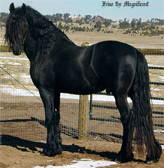Bathing a horse in the winter isn’t a lot of fun for the horse or the owner. Cold temperatures and cold water just don’t go together! Eventually, the mud will dry and disappear, but if you can’t wait for that to happen because you have a show or event, follow these steps to make that winter bath session a little more tolerable.

Plan Ahead
Prepare yourself for the task by gathering a large bucket with warm water, a sponge or washcloth, shampoo, old towels, sweat scraper, and a cooler. Avoid shampoos that need to sit on the horse for a few minutes before rinsing. It is good to keep in mind that dishwashing liquid is not recommended for winter washing as it will leave the skin and coat dry. Dry, itchy skin opens the pathway for infectious skin disease. Dirty blankets can also lead to skin problems.
Choose the Location
Ideally, you will have a draft-free wash stall with warm water. But many times conditions are less than ideal. You’ll need to bathe the horse inside, away from drafts. You can bathe in his stall where bedding can soak up water and be replaced. This will help eliminate icy patches so you don’t fall.
Wash Only the Areas you Must
If your horse needs a medicated shampoo bath because of a breakout on his neck, just bathe the neck. If you must bathe the entire horse, do the front half first, then the back half. As you wash, scrape off excess water with a sweat scraper then rub the wet area briskly with a thick terrycloth towel to remove additional moisture. It is important to use a sweat scraper to scrape the coat thoroughly after a winter bath. A rubber edged scraper will conform to the contours of the horse’s skin and remove more water. Use the terry cloth towel or scrap fabric to towel dry as much moisture off the body and legs as you can.
Use a Cooler
After towel drying place a few dry towels across the horses back then place a cooler on the horse. It is important to use a cooler and not a blanket as blankets are meant to protect a coat from rain and snow. This means that they won’t be able to vent moisture on the coat away from the body. Once the cooler is on, walk your horse around in the warmest area you have access to; an indoor arena, barn aisle or up and down a windbreak outside.

In about 10-15 minutes remove the towels from under the cooler. They will be damp and will expose the dry cooler to the fur so that it can wick more moisture from the coat. Your horse doesn’t need to continue walking but make sure you keep an eye on him to make sure he doesn’t get a chill. In very cold temperatures, offer your horse a hay bag so they can use the natural warming process of digestion.
The drying process can take anywhere from one to several hours to complete depending on the thickness of their winter coat. You can place them back in their stall after a while, just make sure to stay nearby until they are fully dry.
As you can see, washing your horse in the winter is something you can do as long as you plan ahead and take your time.
Don’t forget to contact us anytime with your questions on keeping your horse healthy this winter!





; ?>/wp-content/themes/twentyten/img/NMImacLogo_150.jpg)






